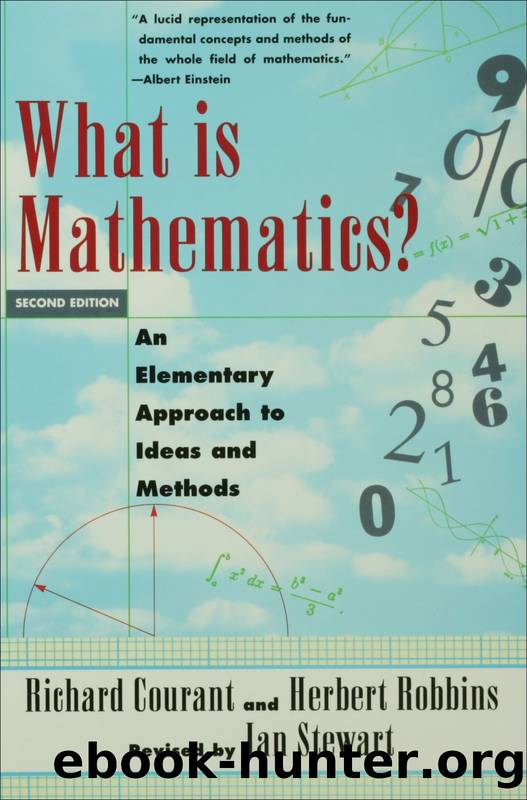What Is Mathematics? : An Elementary Approach to Ideas and Methods (9780199754878) by unknow

Author:unknow
Language: eng
Format: epub
ISBN: 9780195105193
Publisher: OxfordUP
Published: 1996-09-15T05:00:00+00:00
Fig. 143. Closed surfaces defined by coördination of edges in plane figure.
Fig. 144. Three-dimensional torus defined by boundary identification.
Fig. 145. Another representation of three-dimensional torus. (Figure cut to show identification.)
APPENDIX
*1. The Five Color Theorem
On the basis of Eulerâs formula, we can prove that every map on the sphere can be properly colored by using at most five different colors. (According to p. 247, a map is regarded as properly colored if no two regions having a whole segment of their boundaries in common receive the same color.) We shall confine ourselves to maps whose regions are bounded by simple closed polygons composed of circular arcs. We may also suppose that exactly three arcs meet at each vertex; such a map will be called regular. For if we replace every vertex at which more than three arcs meet by a small circle, and join the interior of each such circle to one of the regions meeting at the vertex, we obtain a new map in which the multiple vertices are replaced by a number of triple vertices. The new map will contain the same number of regions as the original map. If this new map, which is regular, can be properly colored with five colors, then by shrinking the circles down to points we shall have the desired coloring of the original map. Thus it suffices to prove that any regular map on the sphere can be colored with five colors.
First we show that every regular map must contain at least one polygon with fewer than six sides. Denote by Fn the number of regions of n sides in a regular map; then, if F denotes the total number of regions,
(1) F = F2 + F3 + F4 + · · ·.
Each arc has two ends, and three arcs end at each vertex. Hence, if E denotes the number of arcs in the map, and V the number of vertices,
(2) 2E = 3V.
Furthermore, a region bounded by n arcs has n vertices, and each vertex belongs to three regions, so that
(3) 2E = 3V = 2F2 + 3F3 + 4F4 + · · ·.
By Eulerâs formula, we have
V â E + F = 2, or 6V â 6E + 6F = 12.
From (2), we see that 6V = 4E, so that 6F â 2E = 12.
Hence, from (1) and (3),
6(F2 + F3 + F4 + · · ·) â (2F2 + 3F3 + 4F4 + · · ·) = 12,
or
(6 â 2)F2 + (6 â 3)F3 + (6 â 4)F4 + (6 â 5)F5 + (6 â 6)F6 + (6 â 7)F7 + · · · = 12.
Hence at least one of the terms on the left must be positive, so that at least one of the numbers F2, F3, F4, F5 is positive, as we wished to show.
Now to prove the five color theorem. Let M be any regular map on the sphere with n regions in all. We know that at least one of these regions has fewer than six sides.
Download
This site does not store any files on its server. We only index and link to content provided by other sites. Please contact the content providers to delete copyright contents if any and email us, we'll remove relevant links or contents immediately.
Essentials of Geology by Stephen Marshak(389)
Spectral Geometry and Inverse Scattering Theory by Huaian Diao & Hongyu Liu(280)
Probably Overthinking It: How to Use Data to Answer Questions, Avoid Statistical Traps, and Make Better Decisions by Allen B. Downey(269)
The Readable Darwin by Pechenik Jan A.;(263)
Hydrocarbon transformations in sediments from the Cathedral Hill hydrothermal vent complex at Guaymas Basin, Gulf of California ââ¬â A chemometric study of shallow seep architecture by unknow(262)
How to succeed in EPSO numerical reasoning tests by Franco Reverte José María(239)
Great Ways to Learn Anatomy and Physiology by McKissock Charmaine;(232)
Quantum International Relations by James Der Derian(231)
Research and Publication Ethics by Santosh Kumar Yadav(231)
Mathematical Models in Economics. Lections by Shananin(230)
Weathering: Types, Processes and Effects: Types, Processes and Effects by Matthew J. J. Colon(226)
Dark Matter in the Universe by John N. Bahcall(223)
Fusion of Defects by Arthur Bartels; Christopher Douglas; André Henriques(214)
Cosmic Rays by Alessandro De Angelis(211)
Sampling by Lohr Sharon L.;(205)
Mathematics Booster-1 by Singh Manoj Kumar(205)
The Structure of Scientific Inference by Mary B. Hesse(204)
Pearls from a Lost City: The LVOV School of Mathematics (History of Mathematics) (History of Mathematics, 40) by Roman Duda(199)
Flora Unveiled by Taiz Lincoln;Taiz Lee;(190)
